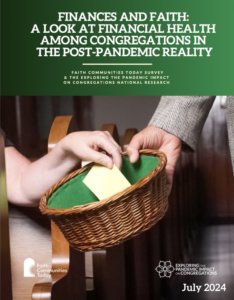Lovett H. Weems, Jr. shares information on how the pandemic affected congregations financially, drawing on data from a recent Hartford Institute report. Overall, the report found that the fiscal health of faith communities was not dramatically altered by the pandemic, with the majority of congregations reporting that they are in excellent or good financial health.
The pandemic skewed all church financial trends, but differently, depending on the circumstances of each congregation. Now we have detailed research on how the pandemic affected congregations financially conducted by the Hartford Institute for Religion Research and funded by the Lilly Endowment, Inc. The report, Finances and Faith: A Look at Financial Health Among Congregations in the Post-Pandemic Reality by Charissa Mikoski, Ph.D., covers a range of financial topics. In the article below, we have highlighted several of the noteworthy areas.
Income of congregations
- Median income of congregations increased between 2010 and 2023 but not enough to keep up with inflation. As a result, churches overall have less buying power now.
- While churches vary in their income by denominational traditions, the most important factor in a congregation’s income is their number of participants.
- Eighty-five percent of congregational income is from tithes and offerings, with 15 percent from other sources. The number of sources, however, varies significantly across congregations.
- Thirty-three percent of churches receive all their income from tithes and offerings while 58 percent of the remaining churches receive income from only one other source.
- The most common sources of other income are fund raisers (35 percent), a combination of investment and endowment income (34 percent), and rental income (29 percent).
Expenses of congregations
- Churches spend the highest percentage of their budget for salaries and benefits (43 percent), followed by buildings and operations (26 percent), missions (13 percent), program and materials (11 percent), and other (6 percent).
Online giving
- The pandemic changed the way churches approach online and other alternate ways of giving. By 2023, two-thirds of congregations offered online giving, up from 31 percent in 2015.
- Almost all churches with 250 or more attendance offer online giving, while only a quarter of churches with 50 or fewer worshipers do so.
- In 2023, churches reported that 30 percent of their gifts came through online giving, up from 10 percent in 2020.
Per capita giving
- The number of donors is down, but per-person giving is up. The median per capita giving increased from $2,000 in 2020 to $2,222 in 2023, though not enough to compensate for inflation.
- Smaller churches with 100 or fewer worshipers have per capita giving about 15% higher than larger congregations.
- Churches in decline (5 percent or more decline from pre-pandemic levels) have higher per capita giving than those reporting more people in 2023 (5 percent or more from pre-pandemic levels). Declining churches often have fewer people giving more by necessity, while growing churches often grow with new people who are younger and less spiritually mature than their current membership.
- Churches offering online giving have higher per capita giving than those who do not.
How do churches say they are doing?
- In 2023, about a quarter of congregations reported that they were in “excellent” financial health, more than a third (35%) reported “good” financial health, and about 28% said “tight, but we manage.” Only about 1 in 10 reported that they were in “some” or “serious” financial difficulty (8% and 3% respectively).
- About a quarter of congregations reported being worse off financially in 2023 than they were in 2018; a fifth had improved their financial situation; and the largest share had remained constant.
- Neither the urban-rural location nor the size of the congregation had an effect upon being in a better or worse financial position now.
Conclusions
The report finds that while the pandemic disrupted all aspects of congregational life, it has not dramatically altered the fiscal health of faith communities at this point. Increased financial need resulted in greater individual giving from a smaller number of total contributors. Inflation rates meant few churches saw any actual net financial growth.
The pandemic hastened the adoption of a variety of new ways of giving by congregations, but member use varies considerably. Nevertheless, online forms of giving do increase the per capita amounts collected. The pandemic seems to be increasing the interest in diversifying the sources of income, though most funds still come directly from the contributions of individual members.
Despite these challenges, a majority of church leaders report their congregations have “good” or “excellent” financial health—an increase over 2020 figures. The report concludes with one certainty: “this is a time of challenge and transition that requires creative thinking” so that your church can be funded and sustained into the future.
 Finances and Faith: A Look at Financial Health Among Congregations in the Post-Pandemic Reality from Hartford Institute for Religion Research
Finances and Faith: A Look at Financial Health Among Congregations in the Post-Pandemic Reality from Hartford Institute for Religion Research
Related Resources
- Funding Forward: Developing New Revenue Sources for Your Congregation featuring Grace Pomroy — Watch the Leading Ideas Talks podcast video | Listen to the podcast audio version | Read the in-depth interview
- 7 Strategies to Engage New Givers by Ann A. Michel
- The Promise of Digital Giving by Ann A. Michel






